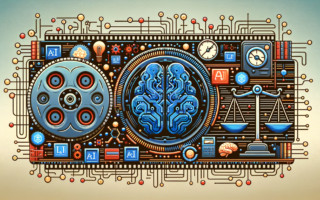In recent years, the emergence of deepfake technology has sparked both fascination and concern. These AI-generated videos and images manipulate audio and visual content to create highly realistic but entirely fabricated footage.
While deepfakes have garnered attention for their potential use in entertainment and political manipulation, they have also become the subject of documentaries aiming to explore their implications on society.
In this blog post, we’ll get into the world of deepfake documentaries, examining how they balance facts and fiction.
Understanding Deepfake Technology
Before diving into documentaries, it’s crucial to grasp the fundamentals of deepfake technology. Deepfakes are created using deep learning algorithms, particularly generative adversarial networks (GANs). These algorithms analyze and synthesize patterns from large datasets to produce convincing fake media.
By swapping faces, altering voices, and manipulating gestures, deepfake creators can generate videos that appear authentic to the untrained eye.
The Rise of Deepfake Documentaries
The rise of deepfake documentaries parallels the growing public awareness and concern surrounding deepfake technology. As deepfakes have become increasingly sophisticated and accessible, fueled by advancements in artificial intelligence and machine learning, they have captured the attention of filmmakers, journalists, and audiences alike. This surge in interest has led to a proliferation of documentaries dedicated to exploring the multifaceted implications of deepfake technology on society.
Documentaries serve as a powerful medium for unpacking complex issues and sparking meaningful conversations. With deepfakes posing significant challenges to traditional notions of truth and authenticity in media, filmmakers have seized the opportunity to investigate and illuminate the far-reaching consequences of this phenomenon.
These documentaries often serve as a wake-up call, highlighting the potential for deepfake technology to be used maliciously or to spread misinformation. By presenting real-world examples and expert analysis, filmmakers aim to educate viewers about the capabilities and dangers of deepfakes.
Moreover, they shed light on the broader societal implications, including threats to privacy, democracy, and trust in institutions.
In addition to raising awareness, deepfake documentaries strive to engage audiences on an emotional and intellectual level. Through compelling storytelling and visual storytelling techniques, filmmakers draw viewers into the complex world of deepfakes, encouraging them to grapple with ethical dilemmas and consider the implications for individuals and society as a whole.
Furthermore, the rise of deepfake documentaries reflects a broader cultural shift towards media literacy and critical thinking in the digital age. As the boundaries between truth and fiction blur, there is an increasing recognition of the importance of equipping individuals with the skills to discern and evaluate information in an era of rampant misinformation.
Ultimately, the rise of deepfake documentaries represents a concerted effort to confront and understand the challenges posed by this rapidly evolving technology. By shining a spotlight on the ethical, social, and political dimensions of deepfakes, these films play a vital role in shaping public discourse and fostering informed dialogue about the future of media and society.
Balancing Facts and Fiction in Deepfake Documentaries
Documentaries on deepfake technology walk a fine line between informing the public and sensationalizing the issue. While these films strive to uncover the truth behind deepfakes, they must also engage viewers and capture their attention. As a result, filmmakers often employ storytelling techniques that blend factual information with dramatic narratives.
But balancing facts and fiction in deepfake documentaries is a delicate yet essential endeavour. These documentaries aim to inform and educate viewers about the intricacies of deepfake technology while also captivating their attention with compelling narratives. Achieving this balance requires filmmakers to navigate a complex landscape where truth and manipulation often blur.
One approach to balancing facts and fiction involves incorporating rigorous fact-checking mechanisms and expert commentary into the documentary’s narrative structure. By consulting with cybersecurity experts, AI researchers, and media ethicists, filmmakers can ensure that their documentaries provide accurate insights into the technical aspects of deepfake technology.
In addition, featuring firsthand accounts from individuals who have been affected by deepfake manipulation can add a human dimension to the documentary, reinforcing its credibility and relevance.
At the same time, deepfake documentaries often employ storytelling techniques that blur the line between reality and fiction. Filmmakers may use visual demonstrations and reenactments to illustrate the capabilities of deepfake technology, allowing viewers to see firsthand how easily videos can be manipulated. These dramatized sequences serve to engage viewers emotionally and intellectually, helping them understand the potential dangers of deepfakes in a more visceral way.
However, it’s crucial for filmmakers to clearly delineate between factual information and dramatized elements within the documentary. This transparency ensures that viewers are not misled or confused about the veracity of the content presented.
By clearly labeling reenactments or dramatizations and providing context for their inclusion, filmmakers can maintain the documentary’s credibility while still engaging viewers with compelling storytelling.
Moreover, deepfake documentaries often explore the ethical dilemmas surrounding the creation and dissemination of deepfake content. By presenting different perspectives and engaging in ethical debates, filmmakers encourage viewers to think critically about the broader societal implications of deepfake technology. This multifaceted approach not only enriches the documentary’s narrative but also fosters meaningful dialogue and reflection among viewers.
In essence, balancing facts and fiction in deepfake documentaries requires a thoughtful and nuanced approach. By incorporating rigorous fact-checking, expert commentary, and transparent storytelling techniques, filmmakers can create documentaries that inform, engage, and provoke thought on the complex issues surrounding deepfake technology and its impact on society.
Fact-Checking and Expert Commentary
To maintain credibility, deepfake documentaries often feature fact-checking segments and expert commentary. These segments provide viewers with essential context and analysis, helping them distinguish between reality and manipulation. By consulting with experts in cybersecurity, artificial intelligence, and media ethics, filmmakers ensure their documentaries offer accurate insights into the complexities of deepfake technology.
Human Stories and Ethical Dilemmas
While deepfake documentaries delve into technical aspects, they also highlight the human stories and ethical dilemmas associated with this technology. Filmmakers may profile individuals who have fallen victim to deepfake manipulation or explore the moral quandaries faced by those who create and distribute deepfake content. By weaving personal narratives into their documentaries, filmmakers foster empathy and encourage viewers to consider the broader societal implications of deepfakes.
Visual Demonstrations and Experiments
To illustrate the capabilities of deepfake technology, documentaries often include visual demonstrations and experiments. By showcasing how easily videos can be manipulated, these segments drive home the potential dangers of misinformation and digital deception.
Through side-by-side comparisons and behind-the-scenes footage, filmmakers underscore the importance of media literacy and critical thinking in the digital age.
Notable Deepfake Documentaries
Several documentaries have garnered attention for their exploration of deepfake technology and its impact on society.
Here are a few notable examples:
- “Deepfakes: The End of Truth?“: Produced by BBC Panorama, this documentary investigates the rise of deepfake technology and its implications for democracy and privacy.
- “The Fake News Invasion”: Directed by Kevin Roose, this documentary explores the spread of disinformation and the role of deepfakes in shaping public perception.
- “Welcome to Chechnya”: While not solely focused on deepfakes, this documentary highlights the use of AI-generated facial replacement technology to protect LGBTQ individuals in Chechnya.
Conclusion
Deepfake documentaries serve as important vehicles for exploring the complex landscape of AI-generated media manipulation. By balancing facts with engaging storytelling, these films contribute to a broader understanding of the ethical, social, and political implications of deepfake technology.
As we navigate the challenges posed by increasingly sophisticated deepfakes, documentary filmmakers continue to play a crucial role in raising awareness and fostering critical discourse.
Remember, staying informed and critically evaluating the media we consume are essential steps in navigating the era of deepfakes.



